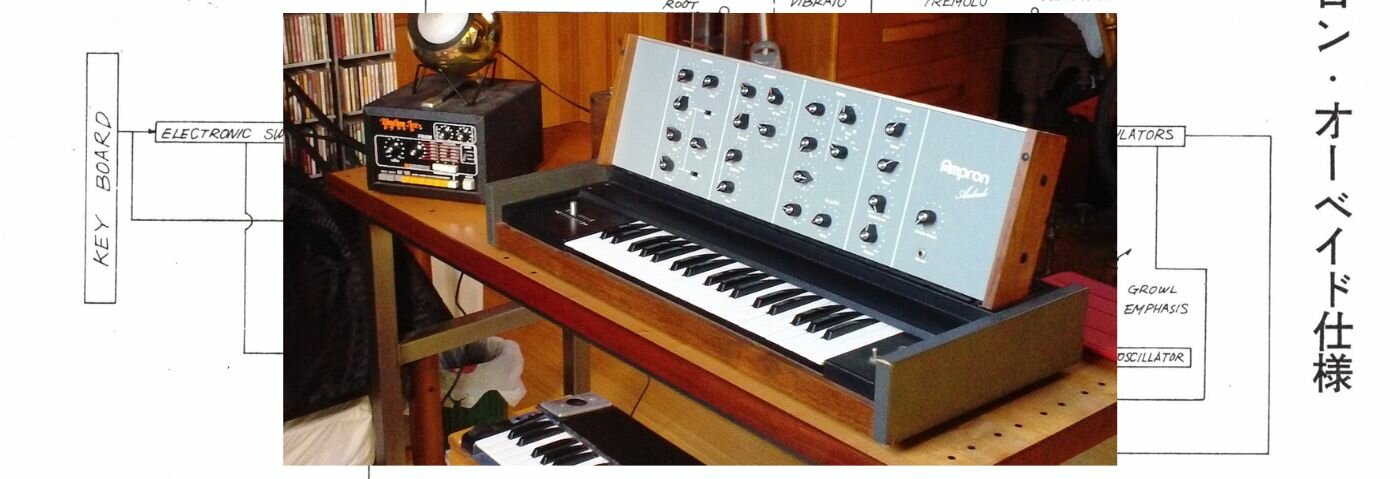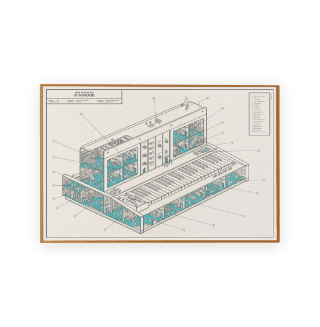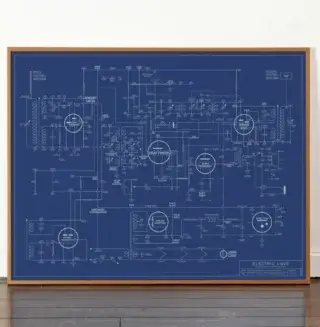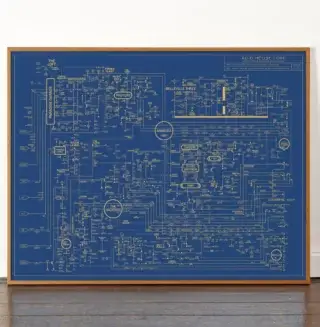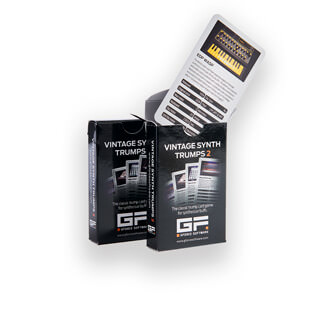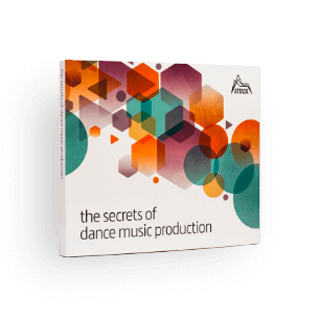This International Synth Day take a journey into the Ampron Aubade. It is one of the rarest and most elusive vintage synthesizers ever made. Little has been known about its origins – until now. With only four in the world, it might have passed you by.
In the world of vintage synthesizers, some are rarer than others. As with other collectables, scarcity drives interest, so the fewer units that were made the more they are desired. Even among such unobtanium instruments like the RSF Kobol Expander, Synton Fenix and EMS Synthi 100, there’s one that trumps them all: the Ampron Aubade.
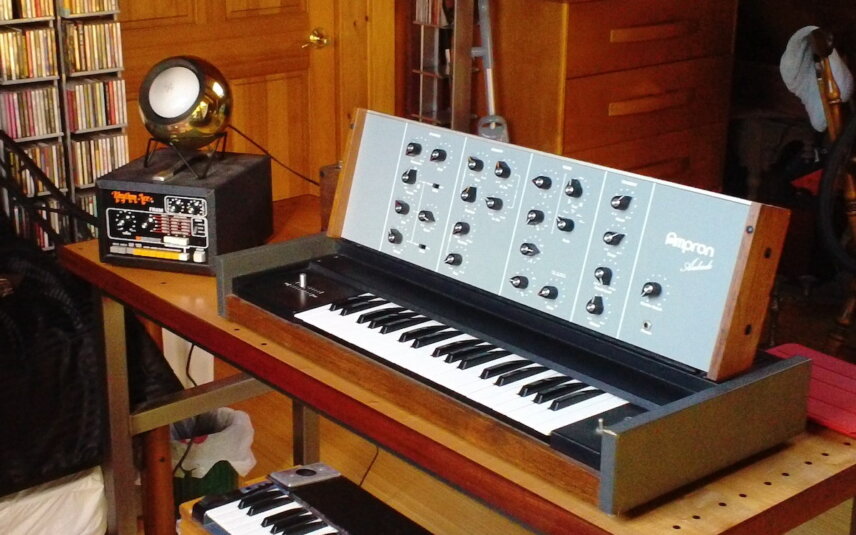
This early 1970s monophonic analog synthesizer is, by all accounts, rarer than the proverbial hen’s teeth. Some say there are fewer than four units extant in the world. The actual number may be even smaller. The most active user, EM Bodwick, has a few videos on YouTube and wrote the entry for Vintage Synth Explorer. The only other known owner was the New England Synthesizer Museum, which had a non-functioning unit. I reached out to them both but didn’t hear back by the time of publishing.
Adding to the unicornness is the mystery surrounding its origins. The name sounds French (aubade means “a dawn serenade to a loved one”) but it could also possibly be Japanese. The small production number suggests a prototype but the solid build quality says otherwise. However, the internal PCBs have reportedly been painted black. This is likely to prevent industrial espionage but also has the unfortunate effect of obscuring any additional clues.
The internal PCBs have reportedly been painted black. This is likely to prevent industrial espionage but also has the unfortunate effect of obscuring any additional clues.
A Light In The Samurai Attic
Late last year, when doing research for an article on early Japanese synthesizer history, I found myself at the wonderful Nakatsugawa Korg Museum in the mountains of Gifu, Japan. Housed on the second floor of an old samurai house, the museum has not only a large collection of Japanese synthesizers but also an incredible library, full of local brochures and catalogs from the early days of the industry.
Tucked in among the pages was a scan from The Music Trades, a musical instrument store trade magazine. There, in the June 1974 issue, was a full article (in Japanese) on the Ampron Aubade, written by the manufacturer itself. Cue bright lights and heavenly choirs.
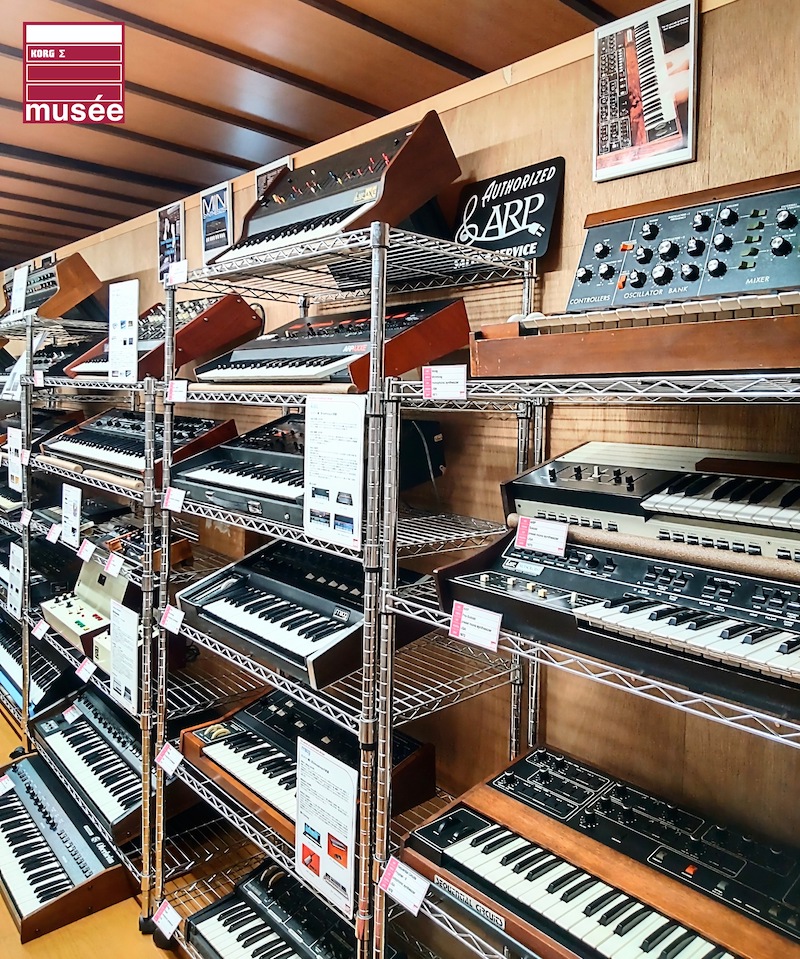
That manufacturer was not Ampron (apparently a dummy company name) but Nihon Univox. However, Nihon Univox is itself something of a mystery. In the words of Ishikawa-san, the owner of the museum, “I have no idea what kind of company this was!” When even Ishikawa-san doesn’t know, you know you’re dealing with a mirage of a synthesizer.
The Ampron Aubade’s Four Design Guidelines
Part of the magazine’s “Our Synthesizer” series, the article laid out Nihon Univox’s goals when designing the Aubade. Remember, this was printed in a trade magazine and shipped to owners of instrument stores as a way to drum up business, so at this point in mid-1974, Nihon Univox had every intention of selling the synthesizer in normal markets.
It must have a keyboard and no presets.
Given the time that it takes to design a synthesizer, we can assume that these guidelines were laid down one or two years before the publication of the article. That would place the timeline in the first half of 1973 at the latest, and 1972 at the earliest. The first local synthesizers to arrive on the Japanese market came in mid-1973 from Korg and Hillwood, and then Roland not long after. At this point then Nihon Univox would probably have been looking to overseas instruments for inspiration. With its flip-top panel, the Moog Minimoog Model-D (1970) is a likely inspiration, at least in terms of form factor. The initial goal was clear: a manual (non-preset) instrument with a traditional piano-style keyboard.
It must be easy to understand with simple controls and lots of space between them.
Nihon Univox was designing the Aubade for the Japanese domestic market, one that had very little experience with synthesizers. Because of this, the instrument had to be easy to understand with fewer controls than, say, an ARP Odyssey or a modular synth. The surprisingly wide-open spaces on the panel have led some to assume that the Ampron was a prototype, for why else would it look so weird? But no, this was a design choice implemented to keep things uncluttered.
It must have excellent qualities as a musical instrument.
This one seems obvious but the point the company is probably making is that it should function as a playable instrument like a trumpet or accordion and not a sound effects machine.
It must have the potential to make the most of the features of a music synthesizer.
To make sure that users could have lots of options, the company wanted to give it plenty of synthesis options. Lastly, the article talks about choosing the name (which the company said was elegant and unique), and that it was exhibited at Messe Frankfurt. So it was out in the world at some point.
Signal Flow of the Ampron Aubade
The front panel (which hinges forward over the keyboard rather than back flat like a Minimoog) has four main sections: Dynamics, Sonority, Timbre and Transient. (The nomenclature is unusual but this is in keeping with early Japanese synths. Korg’s miniKorg 700 has similarly odd parameter names.)
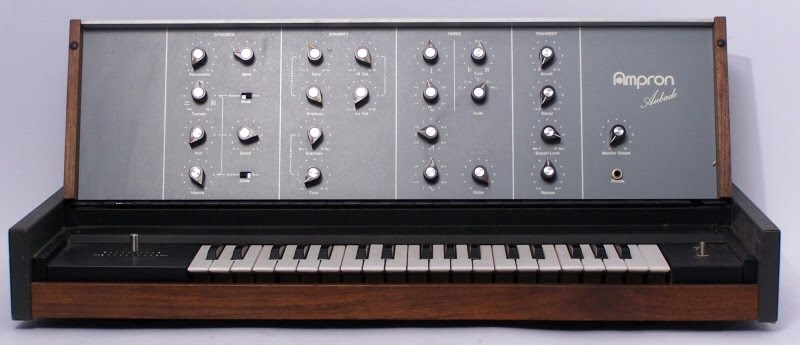
Let’s look at each of these sections in turn. Most modern synthesizers will lay out the controls in the order of the signal flow but the Aubade has them mixed up. For the sake of comprehensibility, I’ll explain them in the order that makes the most sense.
The Timbre section controls the single oscillator. There’s a coarse Tune knob with sheet music symbols for flat and sharp. There’s also the Scale knob for transposing the octaves up and down the three-octave keyboard. There are four waveform dials and here is where things start to get interesting. The first is a pulse spike, a waveform you almost never see on synthesizers, with controls for 0 to 10. Next is a square wave with a bipolar arrangement of 0 at 12 o’clock and then going to +4 clockwise and -4 counter-clockwise. Perhaps this is to control pulse width. Finishing it off are a ramp and sine, each with a similar plus and minus four range. Odd. Finally, there’s a Noise dial that you can pull out to switch off the oscillator.
To the left of the oscillator section is Sonority, or the filter section. There are two filters, a lowpass and highpass (called Hi Cut and Lo Cut, respectively). There’s a separate Resonance section with Tone and Emphasis controls. Very unique. Finally, there’s a Growl section with its own Emphasis and Tone knobs. Growl is a kind of filter distortion that appeared on some early Japanese synths but soon fell out of use.
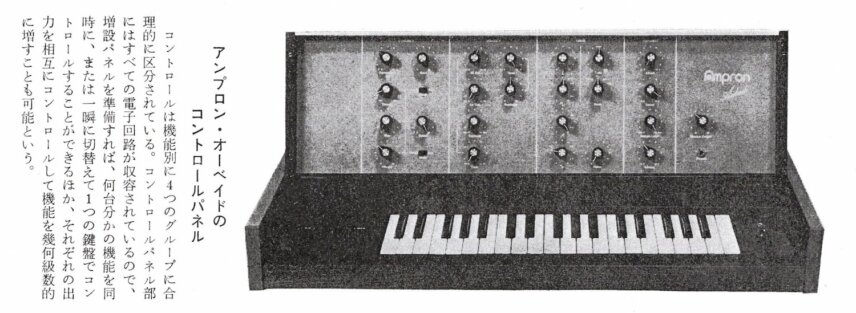
Jumping all the way to the right, we have the Transient section, or what we would call envelope. This has the standard Attack, Decay, Sustain and Release knobs.
The last section (the first on the panel) is Dynamics, which is like an LFO and effects section. At the top is Portamento as well as Bend, which controls the amount of pitch bend applied. The LFO knob is marked Speed and can affect three destinations: Tremolo for amplitude modulation, Wah (filter modulation) and Vibrato (pitch modulation). Both Tremolo and Vibrato have associated Mode switches with selections labeled Overtone and Root. Very unusual.
Finishing out the front panel is the output section, with a headphone jack and Monitor Output dial. The weighted slider on the keyboard controls modulation. Around the back, there’s an input jack for an expression pedal and low and high output ports.
The Circuit Diagram
While a few of the panel controls will make sense to anyone who’s used a synthesizer, like the ADSR, others are pretty cryptic, even if you’re playing the synthesizer, as you can see in this video.
Thankfully, the article in The Music Trades includes a hand-drawn circuit diagram of the Ampron Aubade’s signal path, which sheds some light on some of the more esoteric controls.
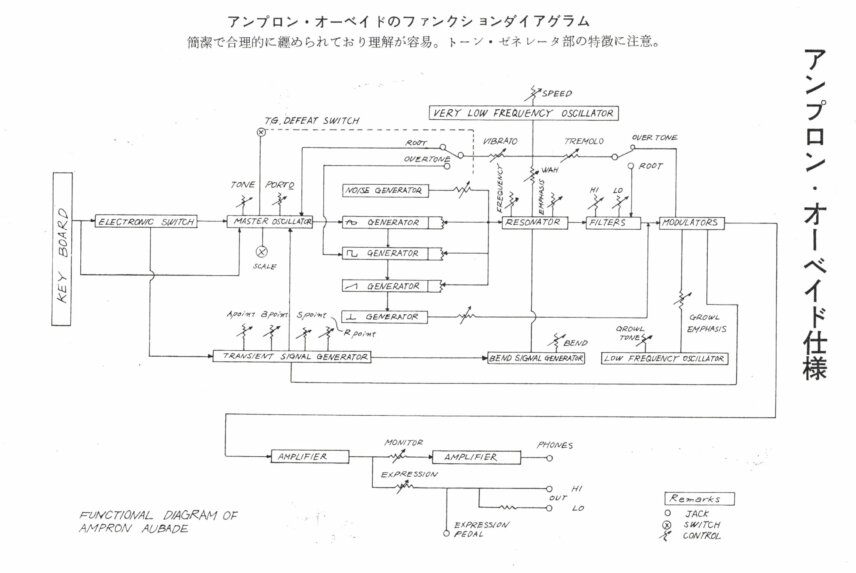
Looking at the diagram, it’s interesting to note that the spike pulse wave bypasses the filter entirely and drops into the main signal path before the Modulators, which would be the Dynamics section. And speaking of the filter, the resonator comes before the filter section, meaning that what they’re calling Resonance on the panel is probably a resonant lowpass filter, with the Hi and Lo Cut knobs acting like shelving EQs.
Finally, the root and overtone switches in the effects section alter the signal path in interesting ways. For the Vibrato, changing to overtone affects just the square wave rather than all oscillator waves, while Tremolo overtone controls just the signal at the filter stage instead of the entire output.
Nihon Univox and the Ampron Aubade
Thanks to the article in The Music Trades, we know that the Ampron Aubade had some pretty unusual design choices for a synthesizer and that it was made by Nihon Univox. With the name Univox attached, Ishikawa-san and I assumed that it was somehow connected to the American musical instrument company Univox, but we couldn’t be 100% sure.
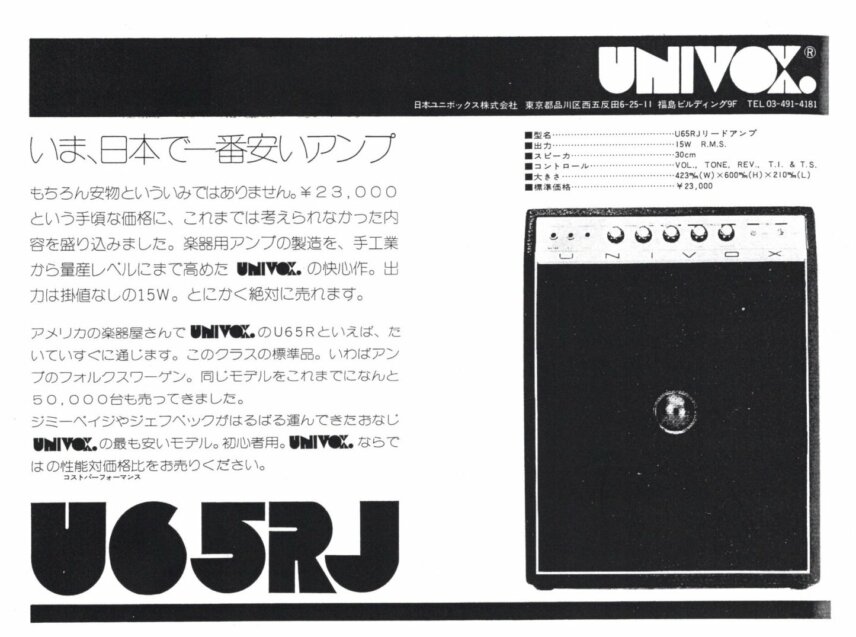
However, while writing this story, I got an email from Ishikawa-san with some very interesting information. He had written to the National Diet Library (Japan’s version of the Library of Congress), requesting scans of any mention of Nihon Univox in The Music Trade. And what do you know? It was indeed the same company.
Looking at the scans that came back, which were advertisements for amplifiers, you could see both the famous American logo and the name and address of the Japanese company. Nihon Univox, then, appeared to be a short-lived Japanese branch of the American company.
More Mysteries of the Ampron Aubade
So what happened? Why didn’t the Ampron Aubade make it to full production? Listening to the synth as demonstrated in the video above, it doesn’t sound all that musical. While interesting and very buzzy, it’s hard to imagine it becoming particularly popular in a broad sense. It’s possible that the reception at Frankfurt Messe was less than stellar. Also, given the exceptionally high quality of the build, it would have been a very expensive machine.
Around this same time, Univox US started a partnership with Korg. Univox had agreements with a number of different Japanese companies in the 1970s and sold their instruments under the Univox name. Korg was one of the bigger ones, which is why you can find some early Korg synths like the miniKorg 700 rebadged Univox. It’s quite possible that Univox found the musical synth they were looking for in the miniKorg and so closed up shop.
From the sound of the name, it would seem likely that the synth was made in a French-speaking country, so quite what Arai/Aria was doing with it is a little mysterious
As for who was doing the designing at Nihon Univox, Ishikawa-san thinks there may be a connection with Shin-Ei, the company that made the famous Uni-Vibe guitar pedal and also a Univox US partner. Peter Forrest’s book, A to Z of Analogue Synthesizers, may also offer a clue. In the very small entry on the Aubade, Forrest writes, “From the sound of the name, it would seem likely that the synth was made in a French-speaking country, so quite what Arai/Aria was doing with it is a little mysterious.” Arai was (and still is) a Japanese guitar manufacturer with a brand called Aria that also worked with Univox in the 1970s. Perhaps Arai was involved with the building of the Aubade or at the very least ended up with the unused units somehow.
If you have any additional information on the Ampron Aubade, please let us know in the comments or write to us.
Thank you to the Nakatsugawa Korg Museum for the invaluable help with this story. The museum is accepting visitors on an appointment basis. Please visit the site for more information.
